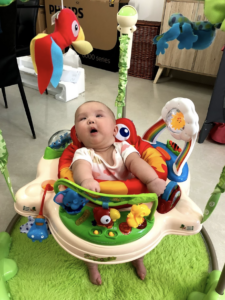When Richard Poulin’s daughter Rylae-Ann was born, it wasn’t long before he and his wife began to wonder if something was wrong. They both felt confident in understanding the typical process of development for children.
“At about three months we began to see fleeting signs, such as crossing her eyes, thrusting her tongue…but we suppressed it, because we figured we were new parents. At the same time, we knew she wasn’t meeting her milestones.”
Her unusual symptoms became more noticeable as time went on. After visiting their doctor, she was sent to the emergency room and diagnosed with epilepsy. Richard was convinced that there was more going on than that, however.

After around eight months had past, Richard’s wife was sent a Facebook post about a child displaying very similar symptoms to Rylae-Ann. This child had been diagnosed with AADC deficiency, a rare disease. The eventually were able to contact a doctor that was an expert in the disorder and had worked on clinical trials. A short visit was enough for him to confirm the diagnosis of AADC deficiency for Rylae-Ann.
About AADC Deficiency
Aromatic L-amino acid decarboxylase (AADC) deficiency is a disorder that impacts the communication of nerve cells. The disease inhibits the production of the signals that play a role in this process, called neurotransmitters. The disorder is linked to mutations of the DDC gene, and AADC deficiency is inherited in an autosomal recessive fashion, meaning that a person must inherit two mutated copies of the gene. Symptoms of the disorder begin to appear within the first few months of life and can include developmental delays, dystonia, dyskinesia, hypotonia, movement disorder, oculogyric crises, and gastrointestinal dysmotility. Less than 1,000 people in the US are believed to live with this disease. While there is no cure for AADC deficiency, physical therapy, speech therapy, occupational therapy, and medications such as selegiline or rotigotine can help control symptoms. Gene therapy for this disease was recommended for approval in Europe. To learn more about AADC deficiency, click here.
A Treatment Success Story
The timing of the diagnosis turned out to be fortuitous for the Poulin family. Thanks to her dual passport, Rylae-Ann was able to participate in an AADC clinical trial that was being held in Taiwan. This trial was evaluating a gene therapy treatment for the disease:
“She was able to have gene therapy when she was 18 months old. The results have just been miraculous. She went from being paraplegic, with spells of symptoms every few days, to being an independent four-year-old.”
While there are still some challenges, Rylae-Ann’s treatment is an incredible success story and Richard realized that they had been extremely fortunate to have been able to get the treatment and participate in the trial. Many other families had been forced to wait much longer for a diagnosis, much less an effective treatment.

Richard decided it was time to give back to the rare disease community and established Teach RARE.
“Our focus is on parents and caregivers since many of the patients we work with are unable to advocate for themselves…the mission of the company is to educate parents and caregivers. There are things you can do to develop a caregiver lifestyle while hitting your goals of therapy.”
Aside from providing education to caregivers, Teach RARE also provides monetary support for families affected by AADC deficiency as well. This is raised through donations, as well as through partnerships with companies and hospitals.
“It was coming back to our personal experience, our journey. As we did that journey, we were meeting other parents, and each time they would have questions for us. Obviously we attribute a huge portion of her success to gene therapy. But we’ve been able to maximize those results because of what we did before gene therapy and what we did after gene therapy.”
Richard says that the number one tip he has for rare disease parents is to trust their own instincts. Often, parents have an intuition that something isn’t right, even when the doctor can’t see it or contradicts their suspicions.
Click here to learn more about Teach RARE.


